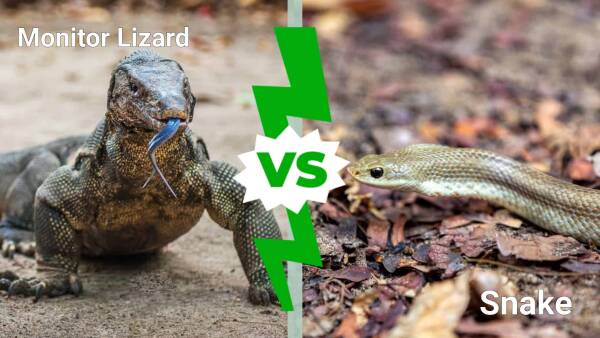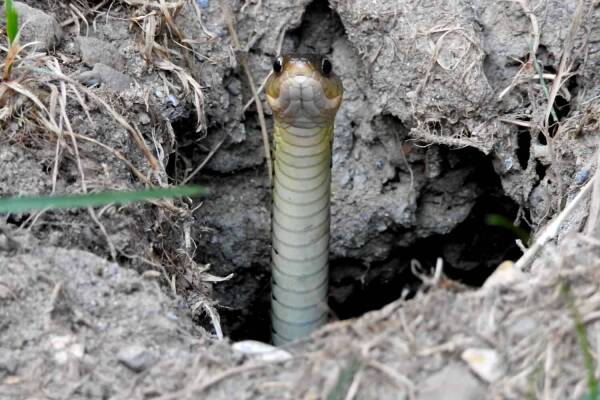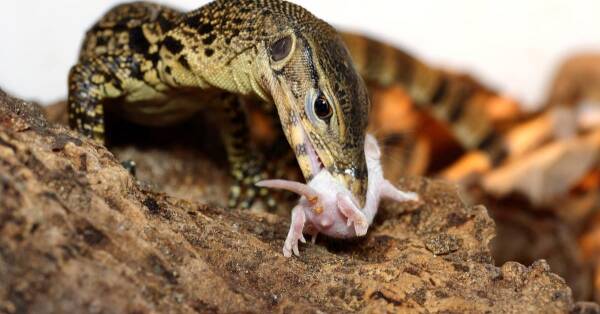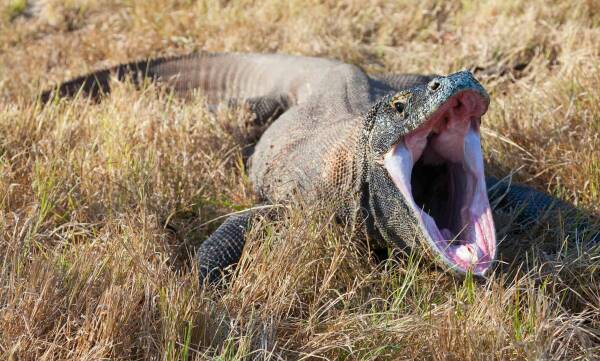Monitor lizards and snakes are two types of reptiles that can be kept as pets or as objects of knowledge or study. Monitor lizards are lizards of the genus Monitor and are typically larger with strong legs and long claws. Snakes are reptiles of the suborder Serpentia, with slender bodies and no legs. The two animals may look completely different, but there are some important similarities between them.

1. Biology

Little Gartner snake sticking out of hole
Snakes may have lost their legs during evolution so that they could better fit into tight spaces.
The most obvious similarity between monitor lizards and snakes is that the two are biologically related. Not only are both reptiles, but both belong to the order Squamata, which includes all lizards and snakes. Lizards and snakes are classified in the same order because physiological and genetic evidence suggests that snakes evolved from lizards. Snakes' ancient ancestors had legs, like modern lizards, but over time they lost them during evolution and developed the ability to move by slithering. Snakes still share some physical characteristics with lizards, such as their scaly skin, which both reptiles shed as they grow.
Monitor lizards, in particular, may be close relatives of living snakes. Some studies suggest that snakes evolved exclusively from platysaurus, a group of lizards that includes monitor lizards and several extinct species. While not all studies support this idea, those that do help explain other things the two reptiles have in common.
2. Diet

What do monitor lizards eat - water monitor lizards eat mice
Most monitor lizards are carnivores and eat a variety of small animals.
Another obvious similarity between monitor lizards and snakes is their diet. Both snakes and monitor lizards are primarily carnivores, meaning they only eat other animals.
Most monitor lizards are carnivores, but a few are omnivores, eating plants and fruits in addition to animals. Many wild monitor lizards eat large amounts of carrion, animals that have died. They also prey on small mammals, birds, other reptiles, amphibians, and crustaceans, as well as bird and reptile eggs. Some of the largest species, such as the Komodo dragon, prey on larger animals such as deer, wild boar or buffalo. Smaller species eat mainly small invertebrates such as insects, millipedes and scorpions. Pet monitor lizards can eat certain foods sold to humans, such as chicken, turkey, fish, shrimp, eggs, and organ meats, as well as whole prey species, such as mice and rats. Smaller pet monitor lizards primarily eat insects such as crickets, mealworms, waxworms, or cockroaches. There are also commercial foods and supplements for pet monitor lizards.
All snakes are carnivores. They swallow their prey whole and, unlike monitor lizards, rarely eat carrion or human food. A snake's preferred prey varies depending on the species of snake and its size, but snakes may eat rodents, other small mammals, birds, other reptiles (including smaller snakes), amphibians, fish, insects, earthworms, slugs Or eggs. Some of the largest snakes, such as anacondas, will occasionally eat larger animals such as deer, monkeys, or capybaras. Many snakes are opportunistic carnivores, meaning they will eat any animal they can catch. Pet snakes need to be fed their entire prey. For most snakes kept as pets, this prey is mice or rats, but some larger species may require larger prey such as rabbits or chickens.
3. Diversity

Close-up of a large tiger reticulated python
Reticulated pythons are the longest snakes, reaching lengths of over 20 feet.
Another similarity between snakes and monitor lizards is that neither is a single species of animal. Both are large and diverse categories containing many different species. Even the selection of species to keep as pets is diverse.
There are approximately 80 species of monitor lizards. They are found in parts of Africa, Asia, Australia, and some islands in the Pacific and Indian Oceans. There are approximately 4,000 species of snakes found throughout the world except Antarctica.
Variety of sizes
Different species of monitor lizards and snakes differ in many ways, but one particularly noticeable change in both is body size. The largest monitor, and also the largest lizard, is the Komodo dragon. The largest known Komodo dragon was 10.3 feet long and weighed 366 pounds. The smallest monitor lizard is the Dampier Peninsula monitor, which weighs less than an ounce and is about nine inches long. Which snake is the largest depends on how you measure them. The longest snake is the reticulated python, which can be more than 20 feet long. The heaviest snake is the green anaconda, which is shorter but larger than the reticulated python, weighing up to 550 pounds. The smallest snake is the Barbados wire snake, which is only 4.1 inches long. These are large size ranges, with monitor lizards and snakes falling somewhere in between these two extremes, which shows their incredible diversity.
habitat diversity
Another difference between the different types of monitor lizards and snakes is where they live. Monitor lizards live primarily in warm climates, but they can also be found in humid rainforests and dry deserts. Some species also live in and around water, while others live in trees. Snakes live in a variety of habitats, including deserts, grasslands, forests, and swamps. There are also aquatic snakes, which can be found in both salt and fresh water. Snakes can be found in all climates except arctic cold climates. In temperate climates, snakes hibernate during the winter.
4. Danger

Yawning Komodo dragon. Rinca Island, Indonesia.
Monitor lizards have sharp teeth and their mouths are filled with bacteria, making bites very dangerous.
One final important similarity between snakes and monitor lizards is that both are potentially dangerous to humans. However, it is possible to stay safe around them by taking the proper precautions. The biggest threat to both reptiles is their bites, which in some species can be venomous.
Venomous snakes are generally the only snake species that pose a significant danger to humans, and only a small percentage of snakes are venomous. However, identifying the species of venomous snake can be difficult, so it's best to keep a safe distance from any wild snake unless you're absolutely sure what species it is. Most non-venomous snakes are completely harmless to humans. They rarely bite, and if they do, they do little harm. Some types of snakes are pythons, which means they kill their prey by wrapping themselves around them and suffocating them. However, pythons rarely try to restrain humans. The most likely source of danger from pythons is accidental injury to humans when large pet snakes crawl onto them.
Some types of monitor lizards are also venomous. Even non-venomous species can be bitten due to their sharp teeth and the bacteria in their mouths. Fortunately, wild monitor lizards rarely attack humans, and since they are found in fewer places than snakes, you are less likely to encounter one. There is a higher risk of injury from a pet monitor lizard, especially if you handle the lizard improperly. Not only can they bite, but they have sharp claws that can also scratch. Even non-aggressive pet monitor lizards can accidentally injure humans while playing with or climbing on them. That's why it's important to know a lot about reptiles before adopting them as pets, especially potentially dangerous species like monitor lizards or large snakes.
animal tags:
We created this article in conjunction with AI technology, then made sure it was fact-checked and edited by a Animals Top editor.